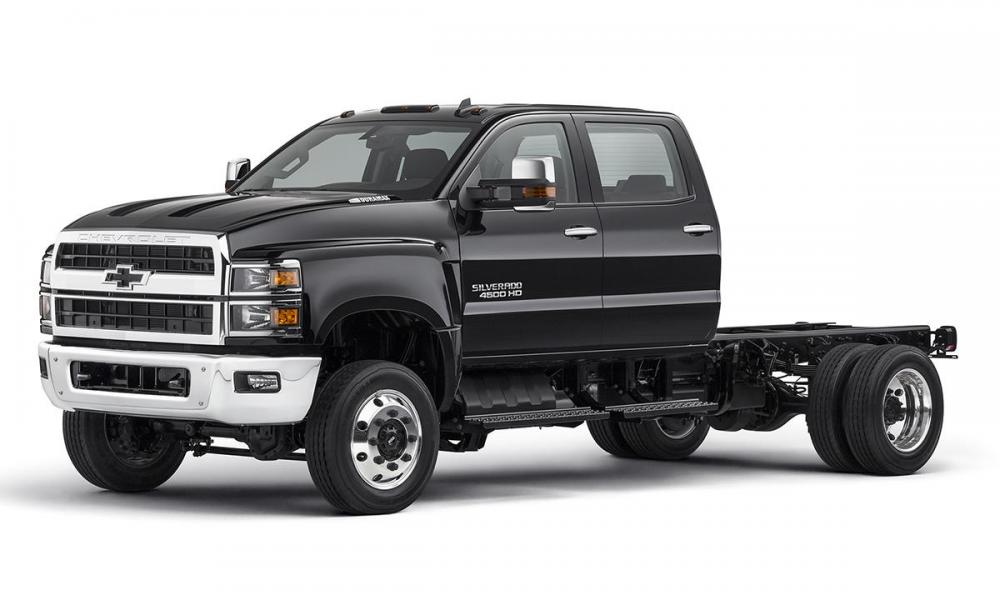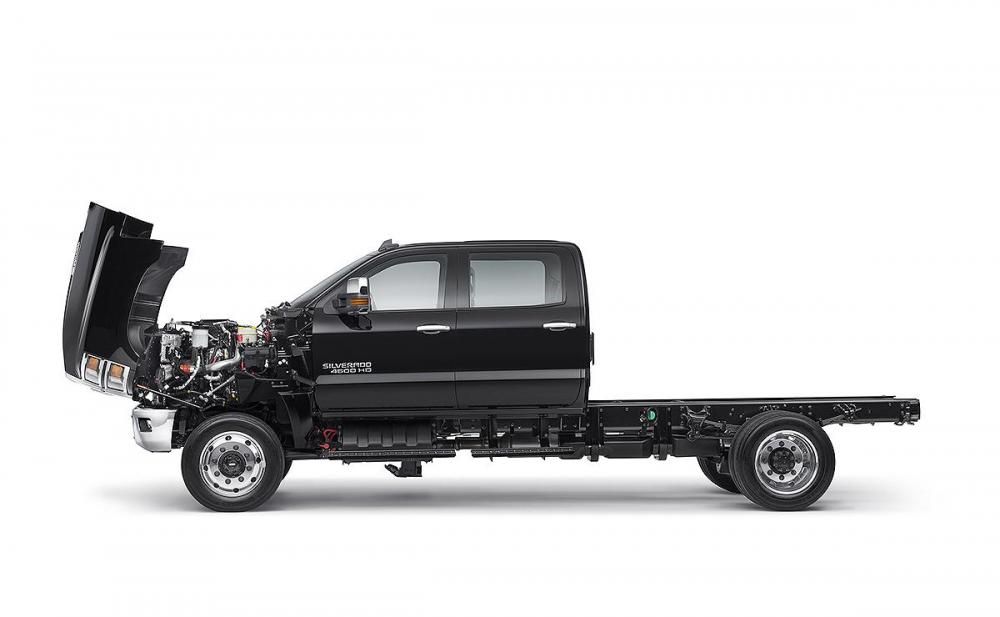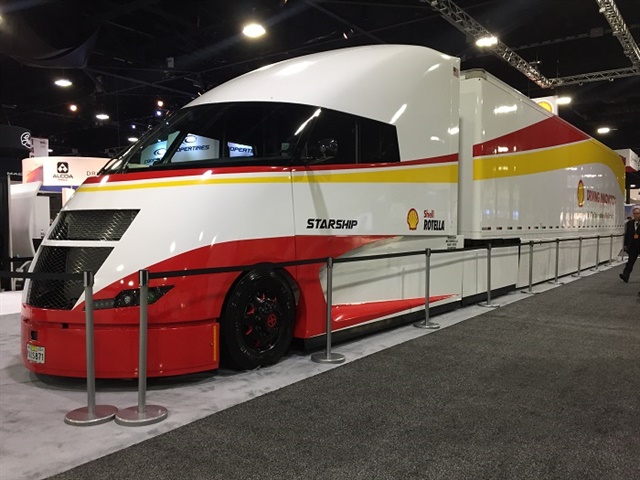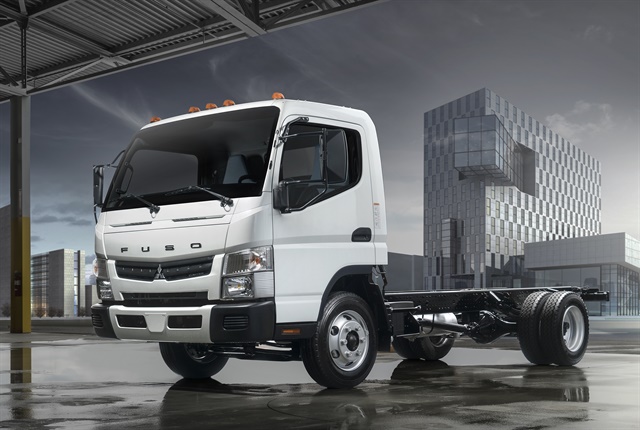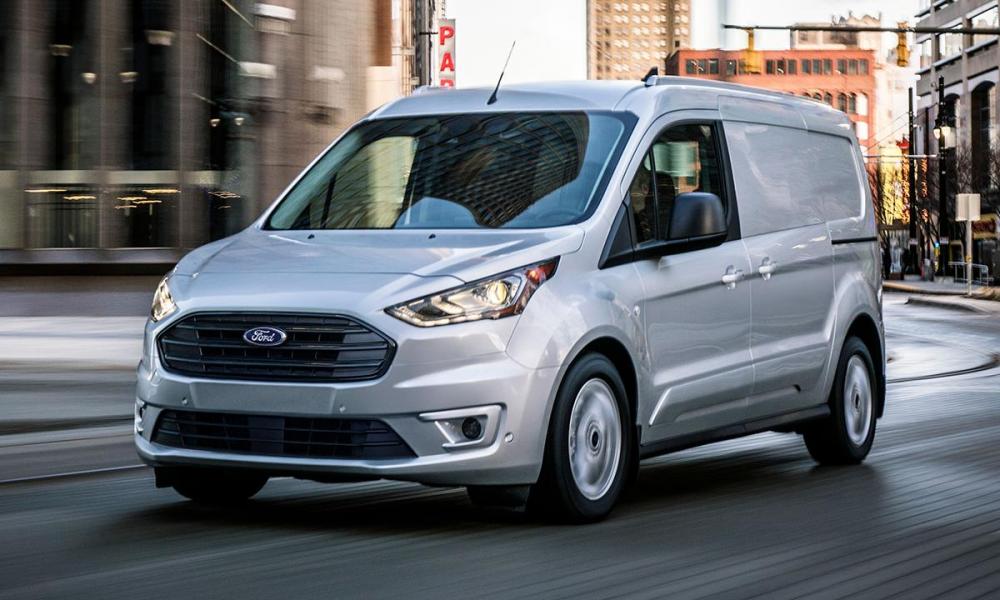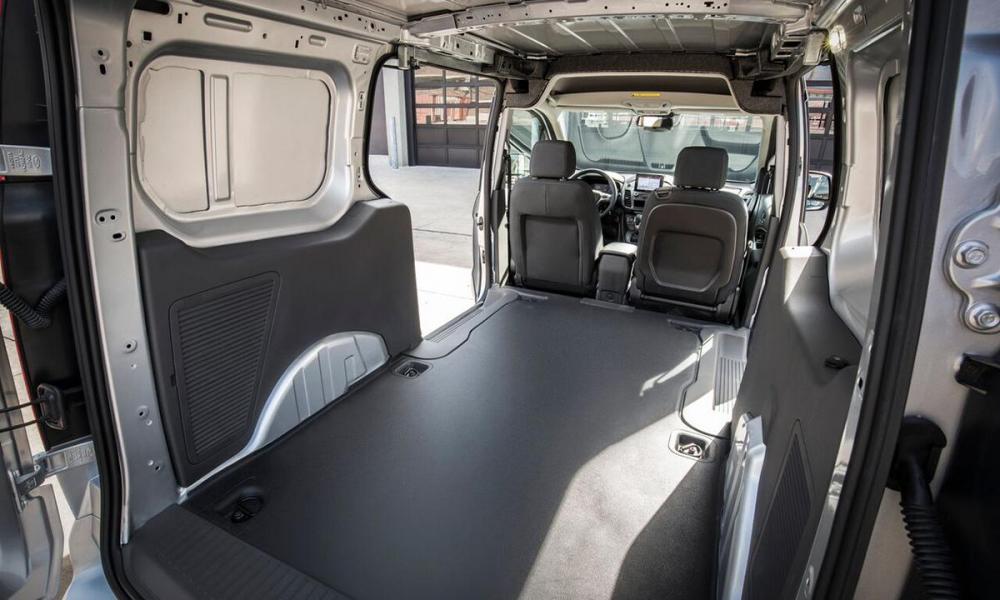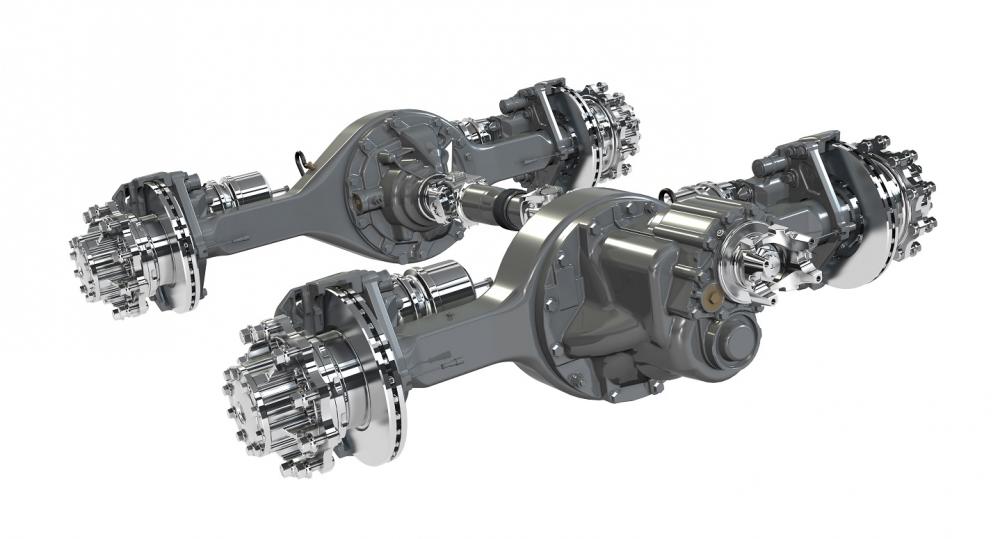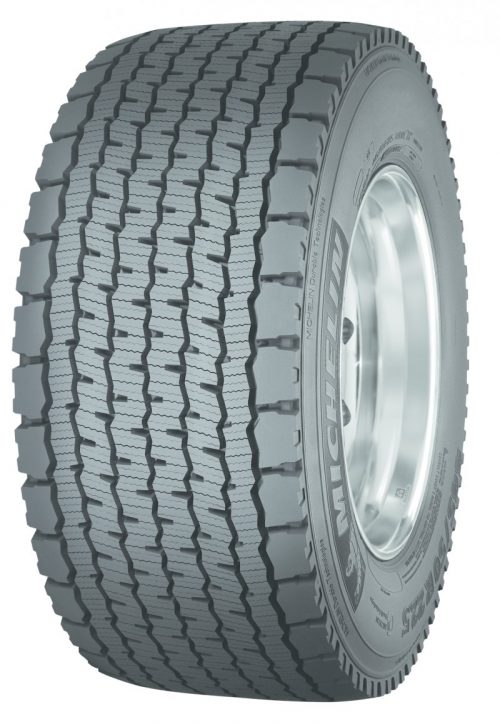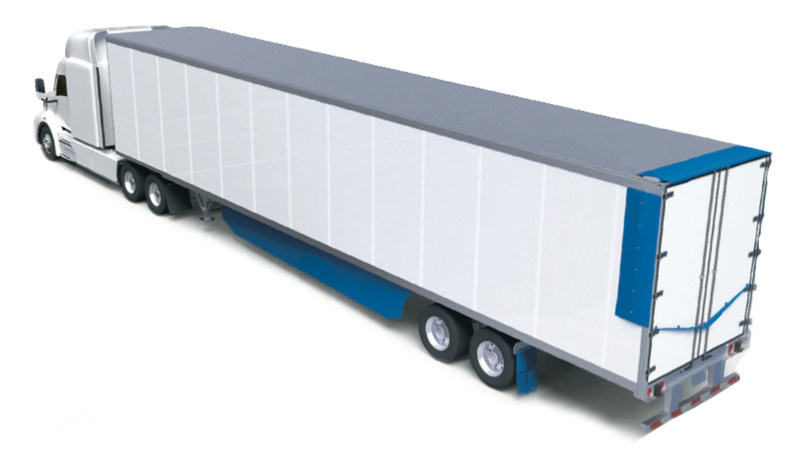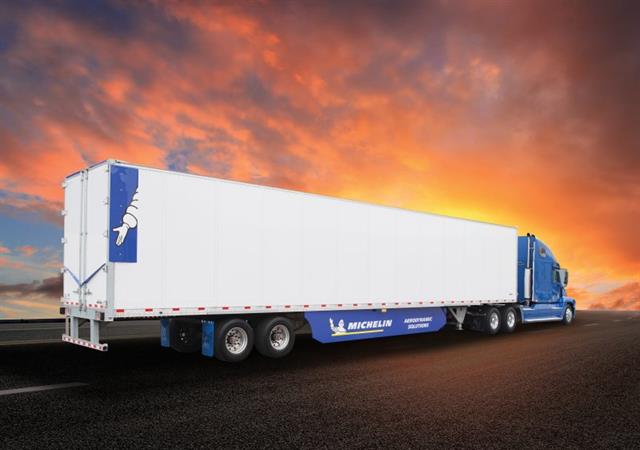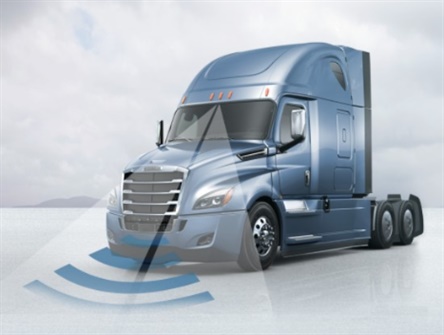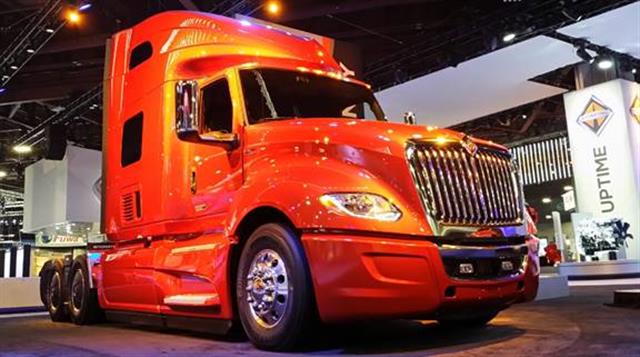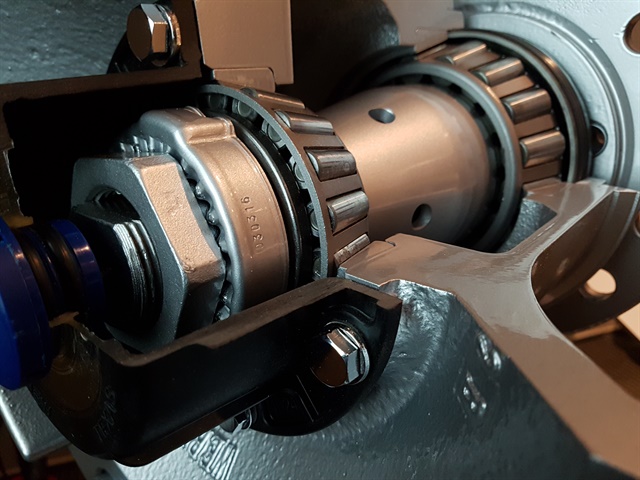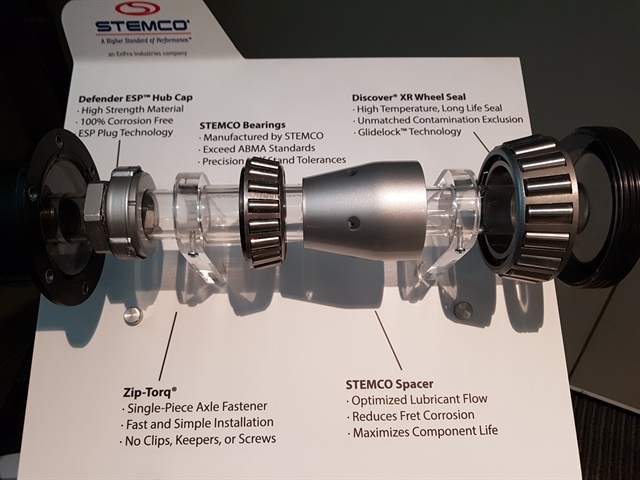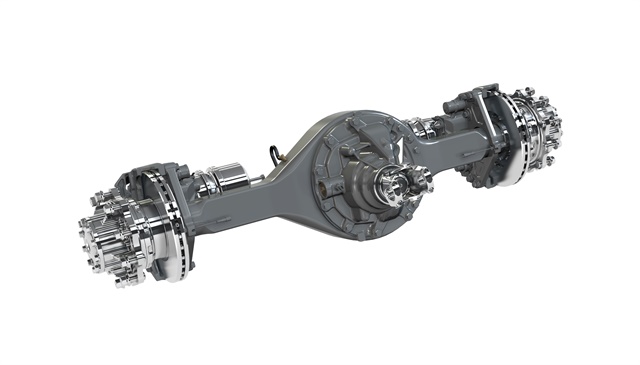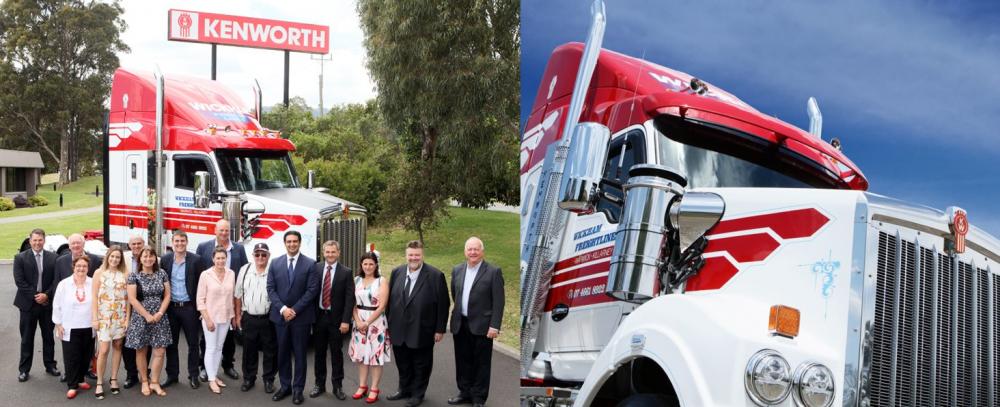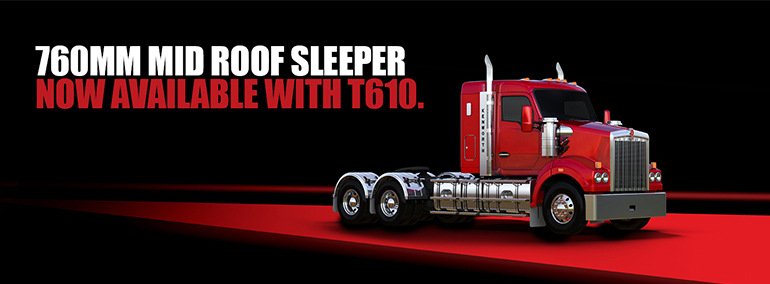
kscarbel2
Moderator-
Posts
18,935 -
Joined
-
Days Won
114
Content Type
Profiles
Forums
Gallery
Events
Blogs
BMT Wiki
Collections
Store
Everything posted by kscarbel2
-
Chevy expands Silverado medium-duty lineup in bid to outgun Ford, Ram Michael Wayland, Automotive News / March 7, 2018 INDIANAPOLIS -- General Motors' new Chevrolet Silverado medium-duty truck will compete in more segments than initially expected, a strategy coinciding with the automaker's plan to expand and improve its commercial dealership network. The automaker, when unveiling the vehicle at the Work Truck Show here Wednesday, said it will compete in Class 6 chassis cab trucks in addition to Class 4 and 5, which were previously announced. The addition helps expand GM's reach and differentiate it from competitors such as Ford Motor Co. and Fiat Chrysler Automobiles, according to executives. "This will be the biggest thing we've ever done for commercial," Ed Peper, U.S. vice president of GM Fleet, told Automotive News on the sidelines of the show. "I think it's a real inflection point in our business. This just says a lot about the support from our leadership and the resources that we're getting to continue to grow this business." Medium-duty trucks range from Class 4 through Class 6 based on gross vehicle weight ratings, which is the maximum operating weight/mass of a vehicle. The new Silverado has a max of 22,900 pounds, which reaches into the middle of the Class 6 trucks, where Ram does not compete, and Ford has a truck but on a different frame than its other medium-duties. "It's a different proposition in the market than what Ford and Ram have," said John Schwegman, GM's U.S. director of commercial product and medium duty. The trucks, which the company has said were built from the ground up and are not variants of existing trucks, are aimed at fleet and commercial buyers and can be upfitted with work-specific beds and boxes for work such as landscaping, emergency services, refrigeration and towing. GM expects to eventually gain upward of a 25 to 30 percent share of the medium-duty truck segment, which would equal its level prior to exiting the segment during the company's 2009 bankruptcy. "We're going to have to conquest largely from Ford, a little bit from [Ram]," Peper said. More important than the sales of the medium-duty segment is the adjacent sales, according to Peper. He said, "For every one of these trucks we sell, we think we're going to sell a van, we're going to sell a pickup and one of something else." The adjacent sales are expected to expand past vehicles to other business segments such as GM Financial, parts and accessories and OnStar, which offers a fleet service with tracking and diagnostic services called Commercial Link. Dealers The adjacent sales are a main draw for Chevy dealers. However, Schwegman said the company is being "very blunt" in letting dealers know they must be committed to their commercial business to be successful. "It's bad for the dealer if they invest in something and aren't ready for it and it's bad for our customers if they have a bad experience -- they get specked into the wrong truck; they have a service experience; a lack of knowledgeable salesperson," he said. "The best for everyone is to be a commercially-focused dealer." GM last week opened enrollment to become a commercial dealer. GM expects to expand its dealer network for medium-duty commercial vehicles, including those produced through a partnership with Isuzu, this year from 240 to about 400 with the introduction of the Chevy Silverado 4500HD, 5500HD and 6500HD. Requirements to become a commercial dealer include training for sales and service staff on commercial vehicles as well as parts and other specifications such as service door heights and lifts to accommodate the trucks. GM estimates the cost to meet the requirements at $100,000 to $200,000. However, Schwegman previously said many of the dealers already have many of the facility requirements. Incremental training and parts could cost just run $10,000 to $15,000 for those dealers, he said. Silverado The medium-duty Silverado trucks, like their light-duty counterparts, feature a mixed-use strategy that includes aluminum, high-strength steel and other materials. They also feature several exterior design characteristics of the current light-duty Silverado. On the interior, the commercial trucks also feature some of the same comfort creatures of the light-duty Silverado on the interior. Some of them include USB chargers, quieter cabins and a built-in 4G LTE Wi-Fi hotspot. The trucks are designed to support wireless cellphone charging and Bluetooth, along with support for Apple CarPlay and Android Auto. They will be available in two-wheel drive and four-wheel drive and will be powered by a 6.6-liter Duramax diesel engine with 350 hp and 700 pound-feet of torque and Allison transmissions with a Power Take Off option. Unlike a decade ago, GM has no plans to sell a medium-duty GMC truck, according to execs. GM did not announce pricing, however it's expected to be $40,000-$60,000. That does not include upfitting charges for specific needs that can cost several times more than the chassis cab. GM partnered with Navistar International Corp. to develop and produce the trucks in Springfield, Ohio. Production is expected to begin in late 2018. Order guides will be available in the spring and exact pricing will be announced this summer. Photo gallery - http://www.autonews.com/apps/pbcs.dll/gallery?Site=CA&Date=20180307&Category=PHOTOS01&ArtNo=307009998&Ref=PH .
-
Shell sponsoring new “hyper-fuel mileage” tractor-trailer design
kscarbel2 replied to kscarbel2's topic in Trucking News
Shell Debuts Fuel-Efficient Starship Concept Truck Heavy Duty Trucking (HDT) / March 6, 2018 Shell and Airflow Truck Company have debuted the full-size version of the company’s Starship Project truck – a concept Class 8 truck that maximizes fuel efficiency using a combination of currently available technologies. The long-teased Starship Project concept truck was finally unveiled at The Technology and Maintenance Council Annual Meeting in Atlanta. The project was first announced in 2015 and was designed by Bob Silwa’s AirFlow Truck Company, which produces hyper-efficient commercial trucks. “We seek projects such as the Starship initiative to keep Shell at the leading edge of technology development and energy efficiency,” said Bob Mainwaring, technology manager for innovation, Shell Lubricants. “The transportation industry is constantly changing, and our goal is to be at the forefront of innovation by collaborating with companies like AirFlow and others to develop creative solutions that provide benefits for years to come.” The body of the Starship Project tractor is a custom-made aerodynamic design made of carbon fiber. This includes the side skirts, hood, and front end. A custom, Department of Transportation-approved wrap-around windshield was designed specifically for the truck. The trailer includes energy efficient features such as full side skirts to reduce drag and a 5,000-watt solar array on top of the trailer to power interior accessories and reduce the energy load. The Starship is powered by a 2017 Cummins X15 Efficiency 6-cylinder engine with 400 horsepower and 1,850 ft.-lbs. of torque that has been paired with a transmission that has been calibrated to run at very low speeds, down to 800 rpm. The truck also makes use of Shell’s low viscosity synthetic lubricants, running on the Shell Rotella T6 Ultra 5W-30, which is an API-FA-4 engine oil that has been formulated to provide better fuel economy, improved high and low temperature performance and meets the requirements for many low emissions engines. It will also use a number of full synthetic Shell Lubricants products including Spirax S6 GXME 75W-80 transmission oil, Spirax S5 ADE 75W-80 differential oil and Spirax S6 GME 40 wheel hub oil. In addition, Shell Rotella Extended Life Coolant will provide excellent high-temperature protection and heat transfer. Shell Rotella Diesel Exhaust Fluid, a high purity diesel exhaust fluid, will also be in the truck. . -
Heavy Duty Trucking (HDT) / March 6, 2018 Mitsubishi Fuso Truck of America will begin selling its gasoline-powered 2019 FE cabovers this month, after showing production-ready versions at the Work Truck Show in Indianapolis. A General Motors-sourced 6.0L V-8 will power a Class 4 and Class 5 FE cabover. The Daimler AG-owned unit will also show a production-ready model of its battery-electric eCanter. The trucks will be sold alongside diesel models. Class 4 models will include the FE140 (14,500 lb. GVWR) and the FE160 (15,995 lb. GVWR). Later this year, Fuso will offer the Class 5 FE180 (17,995 lb. GVWR), which would be the first gasoline-powered Class 5 cabover. In all models, the PSI-GM V-8 engine will make 297 horsepower and 361 pound-feet of torque. Fuso will eventually offer a gaseous-prep package from the factory to allow buyers to use compressed natural gas (CNG) or propane autogas. The trucks come equiipped with a 40-gallon rear-mounted fuel tank. The gasoline engine will be paired with an Allison 1000 automatic transmission with Fuel Sense 2.0 transmission management software, including DynActive shifting technology that improves fuel economy by as much as 6%. The software uses a Neutral-at-Stop feature that further reduces fuel consumption. The FE gasoline trucks will also arrive with enhancements in the cab's interior, including improved driver seat bolstering. The seat cushion has been extended and the seatbelts are now red for higher visibility. Instrument cluster colors have been improved under various lighting conditions, and the trucks now come with an LED cabin light. Storage space has been enhanced with a new driver side console, floor tray, and sun-visor pocket. The truck is available with a black-on-black color scheme with silver trim accents in the interior. The cab improvements will also be offered on diesel-powered trucks. Fuso will assemble the models at the Freightliner Customer Chassis Corp. (FCCC) plant in Gaffney, S.C. .
-
Transport Topics / March 6, 2018 Joe Kory of Navistar announces the company's Renewed branding that makes "a significant investment in our private-labeled product portfolio." .
-
Ford adds diesel option, tech to Transit Connect cargo van Michael Martinez, Automotive News / March 6, 2018 DETROIT -- The technology upgrades and new diesel engine that Ford Motor Co. announced last month for its 2019 Transit Connect wagon are coming to the cargo van variant, too. Aimed at businesses ranging from dog groomers to package-delivery companies, the freshened van is meant to bolster Ford's 46 percent market share in the segment. "It is a critical tool with smart features to help improve productivity out in the field," Tim Stoehr, Ford general fleet marketing manager, said Tuesday in a statement. Ford introduced the Transit Connect to the U.S. in 2010 and last redesigned it in 2014. In 2017, Ford sold 34,473 Transit Connects, nearly double the sales of the second-place Nissan NV200. The company says about 97 percent of the roughly 300,000 small vans sold since its introduction are still on the road. The 2019 cargo van, on sale this fall, will come standard with a 2.0-liter four-cylinder engine mated to an eight-speed transmission. That replaces the 2.5-liter four-cylinder on today's van. A new 1.5-liter EcoBlue diesel engine, also paired with an eight-speed transmission, is available as the only diesel option in the segment. Ford expects it to be rated at 30 mpg highway. The cargo van also will offer a 2.5-liter four-cylinder with a six-speed automatic transmission and a prep package for fleets to use either compressed natural gas or propane. Officials say the vehicle will offer a class-leading towing capacity of 2,000 pounds when equipped with an optional trailer tow package. It will also feature rear cargo doors that swing out 180 degrees and can be locked in the open position to easily load and unload goods. Ford says the 2019 cargo van will come with the most driver-assist technology in the segment. That includes standard automatic emergency braking, part of Ford's efforts to make that technology standard on all of its models by 2022. Available technologies include adaptive cruise control, a blind-spot information system with cross-traffic alert and lane-keeping assist. It will feature a standard embedded 4G LTE modem that provides Wi-Fi for up to 10 devices, part of a companywide initiative to connect every vehicle by 2019. The Sync 3 infotainment system is optional. The vehicle is part of Ford's dominant lineup of commercial vehicles, including the F-series pickup and full-size Transit van. The automaker accounted for 43 percent of all U.S. commercial vehicle sales in 2017 through November, according to Polk registration data. .
-
Dana Launches Spicer S172 Series Single & Tandem Drive Axles
kscarbel2 replied to kscarbel2's topic in Trucking News
Dana shows new axles, updated tire analytics program James Menzies, Truck News / March 4, 2018 ATLANTA, Ga. – Two new lighter-weight axles and an updated tire analytics platform were among product introductions made by Dana at the Technology & Maintenance Council’s Spring meetings. The Spicer S172 single drive axle and D172 tandem axle will replace the 170 series, Dana announced. Steve Slesinksi, director, global product planning for Dana, said the company was able to reduce weight by up to 60 lbs. Both axles come with broad ratio coverage from 3.07 to 6.14. The S172 is aimed at Classes 7 and 8 applications with a gross axle weight rating of 25,000 lbs and a gross combination weight (GCW) rating of 100,000 lbs. The D172 tandem axle also reduces weight by up to 60 lbs, and is well suited for Canadian linehaul applications or heavy-haul work, with a GCW rating of 160,000 lbs. The first OEM to offer the axle will make it available in the second quarter of 2018, Slesinski said. Some of the features include: Dana Spicer AdvanTek gearing design, with wider face gearing; a 20-mm hypoid offset to improve efficiency without compromising strength; a high-strength pinion bearing system; an integrated one-piece carrier design; and a fully autonomous lubrication management system. Tim Farney, global vice-president of Dana’s commercial vehicle division, announced the second-generation Rhombus TireAnalytics system. It builds on the initial platform introduced at this show last year. “It addresses a key maintenance area in the industry, which is tires,” Farney said. “Specifically, it provides tire inspection management consistency, predictive analytics and forward-looking capability, and total life-cycle management tools fleets can utilize to help with the maintenance costs of their tires.” New features include: greater efficiency in gathering tire data using Bluetooth; life-cycle management capabilities using serialization; benchmarking capabilities; tread wear analytics; and tire performance comparisons by region. Farney said it’s the “only system with cradle to grave tracking capability” available in the market. “The Rhombus TireAnalytics 2.0 platform is a great example of the successful digital transformation of Dana, with our continued strategic focus on the customer,” said Mark Wallace, president of Dana Commercial Driveline Technologies. “Our team listened to our customers and upgraded the platform in many ways to enhance the robustness of information the platform provides while also making it more user friendly.” . -
Breaking the electric cost barrier Trailer-Body Builders / March 1, 2018 UPS has commissioned Workhorse to build it electric delivery trucks that cost about the same as diesels. While they promise substantially lower operational and maintenance costs over time, all-electric trucks so far haven't been able to beat their diesel or gasoline counterparts in their initial price tag. Global parcel delivery giant UPS, long an investor in energy sustainability and alternative fuel initiatives, is looking to change things by overcoming that "key barrier to large-scale fleet adoption." The company has engaged Workhorse Group to build it an all-electric Class 5 delivery van that will be "comparable in acquisition cost" to an equivalent conventional fuel van — and that's apples-to-apples, with no special subsidies included for the electric. If Workhorse pulls it off, it would make the argument against electric trucks a more difficult one for fleets whose duty-cycle needs match up. Notably, another Class 5 battery-electric delivery van unveiled recently that garnered some attention, the Chanje V8070, has promised big cost advantages in the long run for fleet use but is expected to carry an initial premium vs. diesel- or gasoline-powered vans. UPS also announced last fall that it's working with Unique Electric Solutions, LLC to develop an electric conversion kit initially for its vans operating in lower Manhattan, New York City. That effort is being supported by $500,000 grant from the New York State Energy Research and Development Authority and will utilize Unique Electric's switched reluctance motor, or SRM, technology. Compared with most electric motors, which use permanent magnets, SRMs have a simpler design with no permanent magnets, lowering acquisition and long-term operating costs. But in this latest endeavor, UPS said it will deploy 50 of the planned new plug-in electric trucks from Workhorse. The vehicles will offer a nearly 400% fuel efficiency improvement over conventional fuel vehicles, according to Workhorse, although the accounting for that claim is yet to be seen; it would need to compare per-mile costs for fuel vs. those of electricity for charging. Workhorse also said the electric delivery vans will have about a 100-mi. range between charges and will have a cab-forward design to optimize driver compartment and cargo area and reduce weight. "Our goal is to make it easy for UPS and others to go electric by removing prior roadblocks to large-scale acceptance such as cost," Steve Burns, Workhorse's CEO, said in a statement. UPS noted that it plans to put the 50 electric delivery vans to use in urban areas including Atlanta, Dallas and Los Angeles. "The all-electric trucks will deliver by day and re-charge overnight," said Carlton Rose, president of global fleet maintenance and engineering at UPS. "We are uniquely positioned to work with our partners, communities and customers to transform freight operation." After Workhorse and UPS have designed the electric van "from the ground up" and produced prototypes, the companies will tweak the design for larger-scale production. UPS said it intends to make these new electric trucks "a standard selection" for its fleet, noting that it operates some 35,000 diesel or gasoline trucks "in routes with duty cycles or daily miles traveled similar to the new electric vehicles," meaning those could be replaced out with all-electric vehicles. It's not the only all-electric trucks UPS is pursuing. The company has pre-ordered 125 of Tesla's planned electric semi-trucks and has purchased three of Mitsubishi-Fuso's eCanter medium-duty electric trucks as well to put to use in its fleet. UPS already operates more than 300 electric vehicles in use in the United States and Europe and has said that by 2020, it wants one out of every four vehicles it purchases to be either alternative fuel or advanced technology like the planned all-electric delivery vans from Workhorse. In its "Rolling Lab" — a growing fleet of more than 9,000 alternative fuel and advanced tech vehicles — UPS has been using and testing Workhorse's hybrid-electric E-GEN trucks for some time. Those run on battery power and feature a small gasoline "Range Extender" engine that kicks in and acts as a generator to provide power when the batteries are depleted, and can also use Workhorse's Horsefly drone to deliver packages.
-
Joe Thompson, Fleet Owner / March 2, 2018 Good news for green fleets! Two tax credits that affect fleets using alternative fuels have been extended. The Alternative Fuel Excise Credit and Alternative Fuel Infrastructure Tax Credit are now retroactively extended through the end of 2017 — a year past the original expiration of December 21, 2016. What does this mean for green fleet owners? Consider these credit examples: For any fleet that purchased propane autogas in 2017, a tax credit of 36 cents per gallon is available. A credit of $4,000 to $40,000 is available on the purchase of new qualified fuel cell motor vehicles in 2017. (The amount varies depending on vehicle weight.) For fleets that installed non-hydrogen alt-fuel refueling infrastructure in 2017, the fueling equipment is eligible for a tax credit of 30 percent of the cost (not to exceed $30,000). How do you file for credits? The Alternative Fuels Data Center says the Treasury Department will provide more details on the process on March 11. Claims may be submitted after Treasury issues guidance. Claims will be paid within 60 days after receipt. While this legislation is a boon for alternative fuel users, we must take steps to keep these incentives in place for the long run. I urge you to contact your elected officials with your support for alternative fuel credits. Another way to advocate for clean alternative energy is through our Clean Cities coalitions. This Department of Energy program has worked since 1993 to cut petroleum use in transportation. Through local outreach and education with stakeholders, the program encourages the use of alternative fuels and vehicles. You can help Congress recognize the value of this program by reaching out to your representative and express your support. If you have questions about alternative fuels or how they could benefit your fleet, leave a comment or call 800.59.ROUSH. You can also join the conversation here.
-
Eaton eyes an electric future, updates Endurant transmission sales
kscarbel2 replied to kscarbel2's topic in Trucking News
Eaton-Cummins prepping Endurant for expansion Sean Kilcarr, Fleet Owner / March 5, 2018 Joint venture looks to expand the reach of its 12-speed AMT in the coming months. ATLANTA. Since its introduction last October, the Endurant 12-speed automated manual transmission (AMT) is witnessing strong growth, according to Scott Davis, general manager of the Eaton Cummins Automated Transmission Technologies joint venture. It is now being positioned to expand into other trucking segments outside of the linehaul market – especially into the heavy haul 110,000 lb.-plus GCVW sector. Right now, AMT penetration is roughly 30% into the heavy-haul market, Davis explained to Fleet Owner, and while he doesn’t expect it to reach the 70% to 80% penetration now being experienced in the linehaul segment, it could be 40% by next year due to a number of factors. Related: Endurant automated transmission: A league of its own “What we see happening is more retirement of experienced drivers and more linehaul drivers moving into this [heavy haul] segment who don’t have the skills with a manual transmission,” Davis explained here during a press conference at the 2018 Technology & Maintenance Council (TMC) annual meeting. “The [AMT] technology is advancing and better integration [with engines] means smoother shifting plus more improved fuel economy. Think also about distraction: drivers must constantly think about shift points with a manual. Then there is fatigue issue: the mental and physical energy expended to manually shift gears, especially in stop-and-go environments. AMTs very good fit for that stop-and-go aspect of linehaul, that regional daycab operation.” Since it went into production in October of last year, Davis said Eaton-Cummins has built and deployed 3,500 Endurant AMTs – “those numbers are probably already outdated as this his has been a very aggressive ramp up for us,” he said – and he expects to see it move into market segments currently covered by Eaton’s Fuller Advantage and UltraShift Plus AMT products. “The key that the Endurant is a ‘purpose built’ AMT so we have optimized its architecture and reduced weight by several hundred pounds,” Davis explained. “AMTs also provide the technical foundation for telematics and predictive cruise, among other features. We can also get data on time spent in gear, how many times manual override occurs, etc. – that helps us calibrate shift schedules better. So if you operate in the Rocky Mountains, we can calibrate [the Endurant] differently versus operating on flat Florida highways. And we’re looking at over-the-air updates for calibration patterns just like engines; there is a lot of opportunity for that.” He added that AMTs “are really going to help us with that transition to newer, younger, lesser-skilled drivers” as well as comply with greenhouse gas (GHG) regulations heavy truck targets expected to go into effect in 2021, 2024, and 2027. “We’ll see a better result with [GHG] compliance by using AMTs – we’ll be better ability to meet the rules,” Davis stressed. “Integration gives you the ability for more consistent fuel consumption on routes, as well help in looking [at the road] ahead as get we get more advanced with smart coasting. Further out, we foresee predictive shifting at cruise to really optimize drive cycles.” He also noted that one feedback point from customers concerned warranty protection for transmission “burnout,” which is something Eaton-Cummins is now offering for the Endurant. Davis added that Eaton-Cummins also remains focused on delivering a “next-generation” Endurant product as well. “Our team is solely focused on automated transmissions; they know how to make the powertrain package work seamlessly as a single unit,” he explained. “You will see a whole pipeline of products as we work on advanced shifting – looking beyond transmission alone to include the entire powertrain as we seek ways to make shifts smoother and faster, including ways to execute more fuel-efficient features.” -
Jeff Crissey, Commercial Carrier Journal (CCJ) / March 4, 2018 With a goal to become a global leader in vehicle electrification, Eaton announced the formation of its new eMobility business unit. The new business unit will be part of the company’s Vehicle Segment business group and will leverage expertise from Eaton’s Electrical Sector business group for use in future development of electric components and power management for passenger car and commercial vehicles. “By partnering with Eaton Electrical, we think we can provide a whole system of smart power management and distribution,” said Larry Bennett, Eaton’s director of engineering, technology and innovation. Eaton expects the adoption of battery-electric commercial vehicles to grow from 2 percent in 2016 to 9 percent by 2030. The company plans to invest $500 million in electrification research and development in the next five years. “The trucks of the future are going to require a lot of intelligence and efficient operation,” said Bennett. “To achieve that efficiency, we need a lot of electrification on board.” Eaton’s roadmap to electrification includes developing a solution to handle multiple voltage levels from various electrical components. “We are starting to see a real increase in electric powertrains, especially in buses and light- and medium-duty vehicles for last-mile applications,” said Bennett. “We now are starting to look at heavy-duty electric vehicle transmissions for drayage applications in ports where trucks have a short cycle and a lot of time spent idling. There are significant advantages in emissions reductions by being able to electrify the various fleets.” Eaton currently is in development of a 48v mild hybrid system that removes all features that run off the engine belt and moving them to the transmission or totally electrifying them. “With engine-off coasting on a downhill grade, you still need to maintain electrical power to all the features on the vehicle,” said Bennett. “By moving the generator to the back side of the transmission and allow the rear wheels to drive this generator when the engine is off while going downhill, you now can provide power for power steering systems, air compressor, cooling systems and fans.” Another use case for electrification to reduce greenhouse gas emissions is a fixed-displacement EGR pump that provides EGR flow independent of engine speed. “All the [engine maker] has to do is tell us how much EGR is needed, and we could control the speed of the motor to provide that exact flow rate,” said Bennett. Endurant update Eaton says it now has more than 3,500 Eaton Cummins Endurant 12-speed automated transmissions in the field with more than 20 million road miles since it was launched at the North American Commercial Vehicle Show last fall. The Endurant transmission was purpose-built for line-haul applications, but Eaton expects to see that product move into some other applications typically served by the Fuller Advantage and UltraShift Plus transmissions in the next several years. Scott Davis, general manager of Eaton Cummins Automated Transmission Technologies, said the joint venture is working on adding new functionality in the near future, including advanced shifting integration technologies and coasting enhancements. “We are looking beyond the transmission into the entire powertrain to make shifting adjustments faster, smoother and more consistent,” said Davis. “With smart coast and neutral coast, you’re going to see us introducing more novel ways to execute such fuel-efficient features looking ahead.”
-
Michelin Unveils Energy Guard Tractor-Trailer Aerodynamic Solution
kscarbel2 replied to kscarbel2's topic in Trucking News
Michelin launches complete aero package, wide-based drive tire Lucas Deal, Commercial Carrier Journal (CCJ) / March 4, 2018 Michelin is expanding out of the wheel well. The company on Sunday introduced Energy Guard, a complete five-piece SmartWay-verified aerodynamic trailer kit for the commercial trailer market. The announcement was made at ATA’s Technology & Maintenance Council (TMC) Annual Meeting in Atlanta. Michelin describes Energy Guard as an “easy-to-use, fuel-efficient and aerodynamic solution.” Consisting of a resilient trailer skirt, trailer-end fairings, aerodynamic mud flaps and a wake reducer, Michelin says its integrated kit eliminates the need for boat tails or combining elements from various vendors. Available for use on 53-ft. dry-van truck load, refrigerated truck load and other long-haul and super-regional applications, Energy Guard “contributes to the sustainable progress” to moving people and goods, says Adam Murphy, vice president, B2B marketing at Michelin North America. “Fleets can be frustrated with the current market solutions for fuel savings as they strive to improve their margins and competitiveness,” says Murphy,“Our Energy Guard solution can result in a 7.4 percent fuel savings. Best of all, it requires no driver interaction in order to achieve these impressive results.” Michelin says the fully-integrated Energy Guard kit boasts several innovations with its patent-pending design. The resilient trailer skirt integrates with other aerodynamic components, while its advanced technology enables coverage and stiffness without sacrificing durability. The skirt’s flexible design folds out of the way if it strikes an obstacle or debris, while the trailer-end fairings direct airflow to the back of the trailer. Michelin says the system weighs around 200 lb. in total. Additionally, Murphy says the wake reducer minimizes the effect of the recirculation zone behind the trailer. The trailer end fairings and wake reducer are automatically functioning, always activated requiring no driver actions. The aerodynamic mud flaps reduce vehicle drag and road spray. Michelin Americas Truck Tires also on Sunday introduced its X ONE LINE GRIP D drive tire. The first launch in the revitalization of the X1 portfolio, the X ONE LINE GRIP D will be available in May. Murphy says the tire is developed to maximize driver confidence in harsh weather operating in long-haul and super-regional routes. Michelin says the tire will meet SmartWay requirements for low-rolling resistance tires and replaces the market-leading wide-base single, the X ONE XDN2. It is available in 445/50R22.5 and 455/55R22.5 sizes, allows fleets to carry 389 lb. of additional payload versus dual-wheel applications, critical for weight-sensitive fleets, the company says. “Protecting drivers and their loads while providing outstanding total cost of ownership are key factors for driver retention, load care and uptime,” Murphy says. “Michelin X ONE LINE GRIP D is the tire for miles of confident driving and all-weather grip while offering the right balance of fuel efficiency, weight savings and long tread life. The latest X One introduction continues our leadership in wide-base single innovation and provides a market-leading solution.” . -
Jack Roberts, Heavy Duty Trucking (HDT) / March 4, 2018 Michelin is one of the oldest legacy companies serving the global trucking industry today. But according to Adam Murphy, vice president of business to business marketing for Michelin, the company doesn’t so much view itself as a “tire” manufacturer today, as it does a supplier of integrated transportation systems. Taken in that light, the launch today of Michelin’s new Energy Guard aerodynamic system for tractor-trailers doesn’t seem like quite the departure it would’ve just a few years ago. According to Murphy, speaking at the Technology & Maintenance Council's annual meeting in Atlanta, Michelin’s approach to tractor-trailer aerodynamics is a solution that increases fuel economy, decreases maintenance costs and requires no driver interaction. Energy Guard consists of a trailer skirt, trailer-end fairings, aerodynamic mud flaps and a patent-pending wake reducer, which Michelin says eliminates the need for “boat tail” fairings or combining aerodynamic products from different suppliers. Murphy said Energy One features several innovations in its patent-pending design, including a trailer skirt that fully integrates with other aerodynamic components. The skirts are made from resilient, modern composites that bend out of the way when striking a objects. The wake reducer is much smaller in size than “boat tail” fairings in use today, Murphy said, but still minimizes the effect of the air recirculation zone that creates drag behind a trailer. Even better, he said, both are systems automatically functioning once installed and always activated without any driver actions. According to testing carried out by Michelin, Murphy said, the new Energy Guard aerodynamic system can deliver 7.4% fuel savings at 65 mph compared to tractor-trailers with no aerodynamic system. This works out to savings of $3,000 and 1,000 gallons of fuel per truck, per 100,000 miles run. All-Weather X One Drive Tire offers 25% better traction in snow and ice Michelin isn’t turning its back on its core business, of course, and drove that point home with the additional introduction of its new All-Weather X One Drive tire in Atlanta Sunday. The tire features new, wide open shoulder grooves to deliver improved grip and traction in ice and snow, which was verified in the 3 Peak Mountain Snow Flake Certification testing carried out in an Arctic test facility. The 25% increase in grip is largely thanks to Michelin’s Matrix siping technology, Murphy said, which features interlocking sipes with zig-zag walls to provide thousands of biting edges for the portion of the tire in contact with the road to provide additional grip in adverse weather conditions. The All-Weather X One tire is SmartWay certified, and features a top layer of dual compound tread to provide long tread life, while the bottom layer features dual compound treads designed to run cooler for longer casing life and retreadability. .
-
Heavy Duty Trucking (HDT) / March 5, 2018 Daimler Trucks North America has announced that the Detroit Assurance 4.0 collision mitigation system and Meritor EX+L air disc brakes are standard on all new Freightliner Cascadia truck models. “The safety of all drivers on the road – whether behind the wheel of a truck or in a passenger vehicle – has always been one of our key priorities. We have made significant enhancements to our trucks that are designed to reduce or mitigate collisions,” said Kelly Gedert, director of product marketing for Freightliner and Detroit Components. “We are committed to continuing to test and develop technologies that can improve the safety of commercial vehicles.” The Detroit Assurance 4.0 suite of safety systems includes Adaptive Cruise Control and Active Brake Assist 4.0. ACC helps drivers maintain a safe, continuous following distance and can be adjusted to following distances between 2.4 and 3.6 seconds. The Detroit Assurance 4.0 collision mitigation system is radar-based and always on. Its bumper-mounted radar tracks the distance from the front of the truck to other vehicles in its path. When a truck gets too close to another vehicle, the driver first receives an audible alarm with visual warning, followed by partial braking, and finally full active braking, where the system slows the truck using the transmission, engine brake and service brakes. In addition to the standard collision mitigation system, the new Cascadia can be spec’d with other optional safety features, such as Lane Departure Warning and Side Object Detection systems. Meritor Air Disc Brakes Additionally, Meritor EX+L air disc brakes will now be standard on all wheel positions for the new Cascadia starting in spring 2018. The EX+L has been weight-optimized and was designed to be the industry’s lightest truck air disc brake, according to DTNA. It features a gear-synchronized twin piston design that adjusts both pistons simultaneously, resulting in better performance and uniform pad wear. The internal adjuster mechanism’s double-sealing technology does not require periodic lubrication, and enhances reliability by keeping contaminants out. “Air disc brakes not only provide a shorter stopping distance, but they are best-suited to support our safety innovations,” said Gedert. “Our partnership with Meritor only adds to the new Cascadia being one of the safest, best-performing trucks on the road today.” .
-
-
Jim Park, Heavy Duty Trucking (HDT) / March 4, 2018 Tractor-trailer aerodynamic device supplier FlowBelow has entered into agreements with a major truck OEM and trailer OE to provide its systems as an optional equipment spec, the company announced during the 2018 Technology & Maintenance Council Annual Meeting Sunday. FlowBelow’s Quick Release wheel covers and Tractor AeroKit System will now be offered as optional equipment on all new International LT and RH Series trucks. The FlowBelow systems can now be ordered through the International dealer network with the installation work completed at the International Truck Plant and Truck Specialty Center. The Tractor AeroKit reduces aerodynamic turbulence on a truck by streamlining air past the drive wheels. FlowBelow also announced that its AeroSlider aerodynamic system will now be offered as a factory-installed option on Strick Trailers and have the system installed at the company’s trailer manufacturing facility in Monroe, Indiana. The Tractor AeroSlider system mounts directly to a trailer’s sliding suspension and travels with it underneath the trailer flooring. The system is designed to smooth out the complex airflow found around trailer wheels and in the wake of a trailer moving at highway speeds. .
-
Jim Park, Heavy Duty Trucking (HDT) / March 4, 2018 The Trifecta Pre-Adjusted Hub Assembly from Stemco could revolutionize wheel installation. Its eye-popping simplicity has left technicians slack-jawed in surprise with its simplicity and ease of installation. The new wheel end system was developed in partnership with Webb Wheel Products and announced at the 2018 Technology and Maintenance Council Annual Meeting and Transportation Technology Exhibit in Atlanta. Designed for safety, performance and confidence, the Trifecta Pre-Adjusted Hub Assembly features the industry-first Discover XR (extreme runtime) wheel seal with GlideLock technology. The seal glides on and is self-locking, reducing installation force by 50%, with no pre-lube required. The combination of the Discover XR wheel seal, Webb Wheel’s hub and the Defender composite hub cap provides the a high level of contamination and corrosion resistance. The Trifecta assembly also features Stemco’s Zip-Torq unitized axle spindle nut, increasing simplicity and safety for end users. There are no additional clips, keepers, snap rings or screws to install. The self-ratcheting locking feature prevents inadvertent back-offs, Stemco says. Additionally, Stemco President Todd Anderson said installation of the new hub assembly requires no bearing adjustment, ensuring the hub is installed correctly, quickly and easily. "When we took this to fleets to demonstrate its ease of installation, technicians went through the procedures and were stunned to discover how simple and repeatable it was and that it no special tools," he said. "The new Zip Torq nut literally allows the mechanic to install, adjust and walk away." Anderson says when installed according to specifications, the wheel end will be well within established TMC tolerance recommendations, "usually somewhere between three-thousandths of an inch of freeplay to a very slight preload, which is absolutely optimal for a wheel bearing." “Trifecta is the latest innovation to combine safety, performance and confidence into one complete package,” explained Mark Holley, segment business leader of wheel end products for Stemco. “By combining Stemco manufactured products with patented technology, the assembly is uniquely developed to extend wheel end life while providing unmatched contamination prevention." Anderson said the Trifecta wheel end assembly has 1.4 million miles of fleet testing behind it to date. It will come with a five-year/500,000-mile warranty for on-highway vehicles, and three-years/350,000 miles for vocational trucks. Trifecta is now available for pre-order; deliveries will begin in the second quarter of 2018. For more information on the Stemco Trifecta Pre-Adjusted Hub Assembly, visit stemco.com/product/trifecta-pre-adjusted-hub-assembly/. .
-
Jim Park, Heavy Duty Trucking (HDT) / March 4, 2018 Dana introduced its new Spicer S172 series single drive axle for Class 7 and 8 vehicles during a press conference at the Technology & Maintenance Council annual meeting in Atlanta. According to Dana, the new axles retains the robustness and strength of the existing S170 drive axle while reducing weight by more than 60 pounds. The axle is crafted for 4x2, 6x2, and 8x2 applications up to 25,000 pounds gross axle weight rating. It offers a broad range of gear ratios, from 3.07 to 6.14, and features a low hypoid offset with High-Power Density AdvanTek gearing to optimize efficiency. The high-strength pinion bearings allow for greater lifespan under heavy loads, improving durability and overall performance, the company says. In addition, a passive lube management system has been added that requires less lubricant overall while maintain optimum lobe flow. "It uses a venturi-cover design to optimize the lube flow in the axle and to make better use of the available lubricant, so we require less lubricant that a standard axle," said Steve Slesinski, director of Dana's global product planning. "We coupled the venturi-cover with a patented lube meter that controls the amount of lubricant going in between the bearing system of the pinion. That helps reduce spin losses due to churning and thus improves axle efficiency." The single drive axle can also be paired with the Dana tag axle as part of the Spicer EconoTrek tandem axle, a durable, lightweight 6x2 configuration that offers increased fuel economy, improved performance, and reduced maintenance for heavy-duty linehaul tractors. This system is up to 3% more efficient and up to 380 pounds lighter than typical 6x4 offerings. The tandem version is more than 60 pounds lighter than existing D170 series tandem axles, and it's available in a broad range of gear ratios, from 3.07 to 6.14, to serve a variety of needs, especially heavy-haul applications such as the Canadian logging sector with GWV up to 160,000 pounds and 50,000-pound gross axle weight ratings. “Dana engineers are continuously examining innovative ways to improve our existing products,” said Mark Wallace, president of Dana Commercial Driveline Technologies. “We were able to build upon the advanced features of the S170 and make it lighter without sacrificing its industry-proven durability and efficiency. We remain a company committed to finding a better way to address the needs of our customers and the commercial-vehicle market.” .
-
The picture above is Communist Party Secretary Li Shufu. He is the largest shareholder of Volvo Group, and thus the Mack brand.
-
How China's Geely sought to buy FCA Luca Ciferri, Automotive News / March 5, 2018 GENEVA -- The most-watched name in the global automotive industry, Chinese billionaire Li Shufu, won't attend the auto show here this week. The founder and chairman of privately owned automaker Zhejiang Geely Holding Group Co., who last month drew a harsh spotlight in Germany by becoming Daimler's largest shareholder, will be keeping his usual distance from the auto world's biggest stages. Li rarely attends auto shows outside China. His public appearances in Europe -- with a contingent of Chinese politicians, entrepreneurs and media -- are typically at events tied to his growing list of European brands. He was in Berlin on Oct. 20, 2016, to unveil Lynk & CO, a near-premium brand co-developed by Geely with Volvo Car, which Li had acquired from Ford Motor Co. six years earlier. He was in England on March 22, 2017, to open the London Taxi Co.'s new facility near Coventry. The 2013 purchase of the legendary black cab maker marked Li's second acquisition in Europe. And he's planning to attend a Lynk & CO event this month in Amsterdam, says a spokesman, who also confirmed Li's decision to skip Geneva. In Amsterdam, Li is expected to announce that Volvo's plant in Ghent, Belgium, will build Lynk & CO cars for Europe. And in the midst of such public appearances, there was a trip to Europe last spring that could have dramatically reshaped the global auto industry -- and Li's expanding role in it. Flight to Turin In May, Li flew to Turin in a Geely-owned jet for a private meeting with John Elkann, the Agnelli family heir who chairs Exor, the holding company that controls Fiat Chrysler Automobiles, said people involved in the trip and the talks. They asked not to be identified, as the meeting wasn't made public. A Geely spokesman in China said "it was normal to have business contacts" but declined further comment. An FCA spokesman deferred any comment to Exor. An Exor spokesman declined to comment. Li was scouting for options to expand Geely outside China. FCA is the third-largest automaker in the U.S., the fourth-largest in Europe, a major player in Latin America -- and weak in Asia. It could have been a perfect fit for Geely, and not only geographically. In a world that is turning to SUVs and premium brands, buying FCA would have given Geely an iconic U.S. marque synonymous with SUV across the world -- Jeep. Geely also would have received such storied sporty brands as Maserati and Alfa Romeo. On top of that, FCA would have added 4.7 million annual vehicle sales -- under the names Abarth, Alfa Romeo, Chrysler, Dodge, Fiat, Fiat Professional, Jeep, Lancia, Ram and Maserati -- in more than 150 markets to the growing Geely empire. FCA has 231,000 workers operating in 162 manufacturing facilities and 87 r&d centers, company data show. In China, Geely's sales were up 45 percent in January, making it the second best-selling automaker. It was No. 5 overall for production, but that ranking includes joint ventures with foreign automakers. Among domestic automakers, it was No. 1. Last summer, amid Automotive News reports of Chinese suitors, FCA said it had had no contact with Geely. Technically, that was accurate, as Li was not talking with FCA but with its controlling shareholder. Exor owned 29 percent of FCA shares and 42 percent of voting rights as of Jan. 10 this year, Exor data show. Differences After Li's trip to Turin in May, representatives of the suitor and potential seller held discussions in private meetings in London in July and August, three sources told Automotive News Europe. The initial offer valued FCA at $20 billion. It constituted Geely purchasing Exor's stake as well as a public tender for the 71 percent of shares held by other investors. The offer was rejected. Geely's emissaries then raised their offer to $22 billion, with no success. Two sources with direct ties to the discussions gave different views on why a deal didn't happen. The first source, speaking under condition of anonymity, said the sweetened $22 billion offer was deemed too low. Exor was convinced it could have extracted more value by selling FCA in parts. Under that scenario, one step would have involved the spinoff or sale of FCA's Magneti Marelli parts business, a move FCA CEO Sergio Marchionne still wants to pull off this year. Another step would have combined Alfa Romeo and Maserati into a separate company to be sold. A third would have seen the Jeep and Ram brands being sold as a package. Finally, the remaining European, U.S. and Latin American businesses would have been offered to a fourth buyer, possibly a Chinese group. The second source said FCA was open to accepting a $22 billion deal if Alfa and Maserati were excluded. Geely rejected that idea. The discussions were over by the end of August. Not an easy surrender Li, 54, the son of a farmer from China's eastern Zhejiang province, has been seen as a Chinese remake of Henry Ford, a century later. He founded Zhejiang Geely Holding Group in 1986, which was at the time focused on refrigerators. He moved into motorbike manufacturing in the 1990s before turning to autos in 1997. The purchases of Volvo and London Taxi and the creation of Lynk & CO followed the Great Recession. Last year, he won control of British sports car maker Lotus, acquired a 49.9 percent stake in Malaysian automaker Proton and spent $3.3 billion to become the biggest shareholder of Volvo, the world's second-largest truckmaker. Then, this year, came the stake in Daimler. Reports surfaced in late November that Daimler had rebuffed advances from Li, who reportedly was seeking to acquire about 5 to 7 percent. Then, last month, Li disclosed that after a series of stock market purchases, he had acquired a 9.7 percent holding in Daimler through the Geely Group, which is owned by Li and managed by Zhejiang Geely Holding. Since moving on from FCA last summer, Li has spent more than $12.5 billion in automotive acquisitions. Considering that he was ready to buy FCA for $22 billion, he could have nearly $10 billion handy for further acquisitions. Getting financial resources seems to be no obstacle. He plays an active political role in China and is a regular delegate to the Chinese People's Political Consultative Conference, a largely ceremonial political advisory body. His political savvy may have helped get the Daimler investment done smoothly, analysts and local media said, especially amid a crackdown by China on overseas deals. In announcing the Daimler deal, China's official Xinhua news agency said Geely reflected a wider "bullish" push by local automakers overseas and the overall "rising strength of Chinese automakers." Li's business ambitions also appear to align with those of China's government, which wants to strengthen the country's high-tech expertise and leapfrog global rivals by becoming a leader in electric vehicles and autonomous driving. But, for now at least, Li's ambition won't include FCA. .
-
Paccar Australia Press Release / December 8, 2017 Australia’s number one heavy-duty truck manufacturer, Kenworth, has delivered its 60,000th Australian-designed and built truck at its Bayswater plant in Melbourne. Andrew Hadjikakou, Managing Director of PACCAR Australia, handed the keys of the T610SAR prime mover to long-standing Kenworth customer Peter Wickham, co-founder of Wickham Freight Lines – one of Australia’s largest privately-owned transport companies, at an event at Kenworth’s head office and factory in the outer eastern suburbs of Melbourne. Andrew said Kenworth’s achievement in manufacturing 60,000 trucks was a major milestone, not only for the company and its dealer group, but for its suppliers, the vast majority of whom are local. “Celebrating key production milestones is a Kenworth tradition, one that began in April 1974 when we handed over the keys to truck number 1,000. Since then we’ve celebrated each major milestone, leading to today, when we hand over the keys to the 60,000th truck that’s rolled off the Kenworth production line since we began designing and manufacturing uniquely Australian trucks in 1971,” Mr Hadjikakou said. Kenworth trucks are the mainstay of Australian transport businesses of all sizes, from large fleets to single owner-operators. Its trucks are also exported to New Zealand and Papua New Guinea. “The heavy-duty truck market in Australia is one of the most competitive in the world,” Andrew stated. “In an industry with no tariff protection, no government financial assistance and often volatile exchange rate movements, Kenworth successfully maintains its status as the market leader against imported brands from the US, Europe and Asia. We continue to successfully deliver high value-added manufacturing – that is, world-class trucks, which provide distinct business advantages,” he said. Andrew said Australia had a diverse range of operating environments unlike anywhere else in the world. Trucks must deal with extreme heat in remote, dusty mines and across deserts. Others must haul loads that are two or three times heavier than overseas, and on rough and unmade roads. Often trucks are required to perform an inordinate amount of hours, some as much as 24 hours a day. “It’s critical this country has a local manufacturer that understands the challenges facing transport businesses. Kenworth is the only local truck manufacturer offering full design capability, technical expertise and resources to application-engineer trucks for the most extreme on and off-road operations,” Andrew explained. “Our trucks are designed to satisfy these unique needs. They feature higher cooling capacities to handle heavier weights and hotter conditions, more robust construction to manage the roughest roads, and embody a design philosophy that means cost-effective maintenance and reliability,” he added. Mr Hadjikakou said Kenworth’s more than 45 years of local manufacturing have a significant ripple effect that has benefited many Australian industries and Australians. The company currently employs more than 1,000 staff in Melbourne, the majority of whom are directly or indirectly involved in the manufacturing operations. It also supports the industry’s best nationwide network of PACCAR dealers who employ about 3,000 people throughout Australia. In addition, the company supports a variety of local suppliers who provide the majority of the parts and materials which make a Kenworth. As part of its manufacturing commitment, Kenworth has made a substantial investment in design engineering. This enables it to purpose-build trucks with short lead times – a feat imported trucks cannot match. “Local design and manufacturing remains the driving force behind our business, and we’re in it for the long haul. We are continually reinvesting in expanding our operations, continually refining our techniques and introducing new technologies. Most importantly, we listen to our customers and we meet their needs,” Andrew added Wickham Freight Lines takes possession of 60,000th Kenworth Mr Hadjikakou said it was fitting Kenworth’s milestone truck was built for Wickham Freight Lines. “Wickham Freight Lines is one of our long term customers,” Mr Hadjikakou said. “They are knowledgeable and passionate about the road transport industry and forthright with their thoughts and opinions, which has contributed to the continuous improvement of our trucks for close to four decades. It’s been a win-win for both parties, and it’s the epitome of how we conduct business with all of our customers.” “It’s gratifying to receive this milestone vehicle,” Darren Eather, Chief Executive of Wickham Freight Lines, said at the official hand-over. “We have been working with PACCAR for many years; it’s being part of a team. They satisfy all of our trucking needs – not just sales, but also finance, servicing and parts. PACCAR and Brown and Hurley take the stress out of maintaining a large and diverse fleet, enabling us to focus on improving our service to customers,” Mr Eather said. Wickhams is one of the largest privately-owned transport companies in Australia. Established in 1992 it specialises in transporting fresh, chilled and frozen meat and produce, as well as consumer products and dry goods, servicing retail supply chains and other logistics providers. With its unique head office in the shape of a Kenworth K108 cabover in Warwick, Queensland, and terminals in Sydney and Melbourne, the company now operates a Kenworth fleet of 160 prime movers with its distinctive red and white livery. Wickhams employs various Kenworth models to handle different applications, but the fleet is predominantly the cabover K200. The company’s latest T610SAR – Kenworth’s 60,000th truck – is powered by a Cummins X15 engine, producing 600 hp and 1850 lb/ft of torque. The engine uses SCR exhaust after-treatment technology for emission reduction, which meets Euro 5 and Australian ADR 80/03 emissions regulations. The truck is equipped with an Eaton Fuller RTLO22918B 18-speed manual transmission, Meritor MF573 (7.3t) front axles and Meritor RT46-160GP rear axles. It also features two 480-litre and two 400-litre rectangular fuel tanks, Kenworth Airglide 460 suspension and an 860mm Aero Roof sleeper. Wickhams’s T610SAR, will go to work transporting meat and produce in refrigerated trailers travelling to approximately 250,000 kilometres a year along the eastern seaboard. Kenworth’s T610SAR is the brand’s latest release. In just one year since its launch on December 3, 2016, it has established itself as a versatile and hard yards specialist, which can manage a variety of applications; including interstate line haul up to 19m B-double and tipper and dog applications. The T610SAR features a significantly wider cabin, which is centred around the needs of the driver. With increased walkthrough space between seats, greater room head-to-toe for the driver, more standing room in the sleeper cabs, the interior is far easier to move around in. With advanced heating and cooling that’s more powerful yet efficient, the cabin maintains optimum temperature at all times. The expansive windscreen offers a panoramic view of the road, the cabin’s superior ergonomics means controls are positioned intuitively and dashboard instrumentation is visible at a glance. With a complete range of active and passive safety features, including advanced collision avoidance technology, the T610 readily adapts to operating conditions to enhance fuel economy with no impact on productivity. Mr Eather says the T610, like all Kenworth models, offers significant advantages compared with other American-style and European brands he has tried over the years. “We have bought almost 250 Kenworths, and we continue to buy them every year because it’s good for business. With Just In Time (JIT) deliveries now the norm, our customers need our trucks there on time every time. Kenworths are designed and manufactured in Australia for Australia’s harsh environments and applications. And Kenworth builds trucks to our exact specifications and requirements – and that makes all the difference,” he said. “Kenworth trucks are more reliable, durable and cost effective to run. They can handle hard work, long hours and many years of service. It’s no wonder our drivers love them. The trucks are also safe and comfortable to operate, and they perform well under any conditions,” he explained. Mr Eather says Kenworth’s nationwide dealer network, in particular Brown and Hurley, also plays an integral role in its transport efficiency. “Our trucks cover a lot of territory, so it’s comforting to know that if they ever have a problem, there’s a Kenworth dealer nearby,” he added. Kenworth trucks, with GCM from 39 to 260 tonnes, cover the full spectrum of heavy and extreme-duty applications. This includes multiple-trailer regional and interstate freight, tipper and dog construction work as well as off-highway operations for the logging and mining industries. .
-
KENWORTH RELEASES NEW T610 SLEEPER CAB OPTION Paccar Australia Press Release / February 28, 2018 Following the introduction of the T610 and T610SAR in early 2017, Kenworth announced today the release of a 760mm mid roof sleeper cab, complementing its existing day and 860mm sleeper cab options and providing customers with even more choice. The new sleeper cab option is suitable for many different applications including 19m tippers, tankers, and 19m B-double applications. Designed from the inside out in a decade-long development process, the T610 cabin is centred entirely on the needs of the driver. Touted as Kenworth’s ‘Best Truck Yet’, the design incorporates greater foot space, more storage, wider walkthrough access between the seats and more expansive door and windscreen glass, providing space, visibility and ergonomics never before seen in Kenworth’s suite of Australian-made trucks. “The core of the T610 project was about building a bigger cab to create the ultimate driver environment, which leads to better all-round driving performance, safety, efficiency and productivity” said Brad May, PACCAR Australia’s Director of Sales and Marketing. “This 760mm sleeper cab option allows even greater flexibility for our customers whose applications demand it. The mid roof allows access under gantries and suits many height restricted truck and trailer combinations and provides an additional 90mm of head room than the day cab.” Significantly wider and with increased walkthrough space between seats and greater room head-to-toe for the driver, the T610 interior delivers the driver a more open and relaxed cabin that is far easier to move around in and rest during breaks. The new mid roof sleeper offers an inner spring mattress with hinged pan for under bunk storage, optional under bunk fridge and open shelving as standard. Kenworth spent significant time optimising the shape and surfaces over the sleeper cab roof to improve the aerodynamics and optimised clearance. The T610 The result of more than 100,000 Australian design hours and more than ten million kilometres of testing and validation, the T610 has been the single largest investment in product development the company has ever made in Australia. From idea to reality, this significant investment in new technologies and design is specifically for the Australian road transport market. The T610 and T610SAR represent everything a Kenworth should be in terms of durability, reliability and safety. Yet the really noticeable product improvements are the superior space, ergonomics and driver comfort and control – the drumbeat behind Kenworth’s ‘Best Truck Yet.’ The T610 builds on a proven approach honed over many years, starting in 1975 with the first Australian designed and manufactured Kenworth, the W900SAR and later the development and evolution of other iconic models such as the aerodynamic T600, and the K series range. It is the culmination of more than 40 years of Australian design and application engineering experience, integrating with a parallel development program drawing on the global resources of PACCAR. The T610 delivers Kenworth’s most innovative, durable and productive truck yet, designed and manufactured right here in Australia for our local conditions and applications. .
-
China market Ford Cargo heavy tractor arrives
kscarbel2 replied to kscarbel2's topic in Trucking News
There's quite a bit of massaging Bob. And most of the parts were resourced from within China. -
At any given point in time, there are thousands of secret agreements between countries, orchestrated by "big business".......the world's wealthy aristocracy who know no boundaries. It's literally impossible for the masses to connect the dots and make any educated guess as to what is really going on.
-
. . . . . . . . . . . . .
BigMackTrucks.com
BigMackTrucks.com is a support forum for antique, classic and modern Mack Trucks! The forum is owned and maintained by Watt's Truck Center, Inc. an independent, full service Mack dealer. The forums are not affiliated with Mack Trucks, Inc.
Our Vendors and Advertisers
Thank you for your support!


